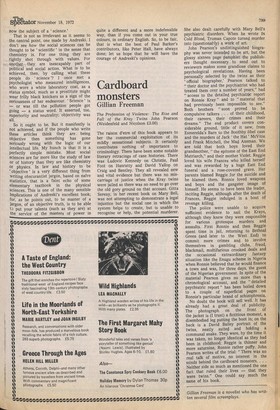Cardboard monsters
Gillian Freeman
The Profession of Violence: The Rise and Fall of the Kray Twins John Pearson (Weidenfeld and Nicolson £3.00)
The raison d'etre of this book appears to ber the commercial exploitation of its mildly sensational subjects. It certainly contributes nothing of importance to criminology. There have been some notable literary retracings of case histories. There was Ludovic Kennedy on Christie, Paul Foot on Hanratty and David Yallop on Craig and Bentley. They all revealed new and vital evidence but there was no miscarriage of justice when the Kray twins were jailed so there was no need to go over the old gory ground on that account. Gitta Sereny, in her recent book on Mary Bell, was not attempting to demonstrate a legal injustice but the social one in which the system helps to create, but is unable to recognise or help, the potential murderer. She also dealt carefully with Mary Bell's psychiatric disorders. When he wrote In Cold Blood, Truman Capote turned murder into (questionably) a work of art.
John Pearson's undistinguished biography was never intended to be art, but the glossy sixteen page pamphlet the publish ers thought necessary to send out to reviewers makes some grandiose claims to
psychological revelations. Having been personally selected by the twins as their 'official biographer,' Pearson talked to "their doctor and the psychiatrist who had treated them over a number of years," had "access to the detailed psychiatric report on Ronnie Kray" and to "material that had previously been impossible to see." Both brothers "soon proved to be compulsive talkers . . . of their childhood, their careers, their crimes and their dreams." The end product covers considerable ground, little of it new, from Esmerelda's Barn to the Boothby libel case and the murders of Jack 'the Hat' McVitie and Frank Mitchell, the Mad Axeman. We are told that both boys loved their grandmother, "the epitome of the East End Matriarch," and their mother Violet. Reggie loved his wife Frances who killed herself and was rewarded by a huge East End funeral and a rose-covered grave. Her parents blamed Reggie for the suicide and he blamed them. Ronnie loved weapons and boys and the gangster image of himself. He seems to have been the leader, inciting Reggie, although after the death of Frances, Reggie indulged in a bout of revenge killing.
The police were unable to acquire sufficient evidence to nail the Krays, although they knew they were responsible for various grotesque murders and assaults. First Ronnie and then Reggie spent time in jail, returning to Bethnal Green (and later to the West End) to commit more crimes and to involve themselves in gambling clubs, fraud, blackmail, multifarious crooked deals and the occasional extraordinary fantasy situation like the Enugu scheme in Nigeria when Ronnie believed that he would finance a town and was, for three days, the guest of the Nigerian government. In spite of the material Pearson gives no more than a chronological account, and the "detailed psychiatric report" has been boiled down to a couple of superficial pages on Ronnie's particular brand of schizophrenia.
No doubt the book will sell well. It has already had a great deal of publicity. The photograph on the front of the jacket is (I trust) a fictitious moment, a disembodied leg putting the boot in; on the back is a David Bailey portrait of the twins, neatly suited l and hdlding a communal snake. They. were, by the time it was taken, no longer identical as they had been in childhood; Reggie is thinner and more saturnine, Ronnie rather puffy. John Pearson writes of the trial: "There was no real talk of motive, no interest in the minds behind the cardboard monsters. . Neither side so much as mentioned the one fact that ruled their lives — that they were twins." One could • say much the same of his book.
Gillian Freeman is a novelist who has written several film screenplays.


















































 Previous page
Previous page